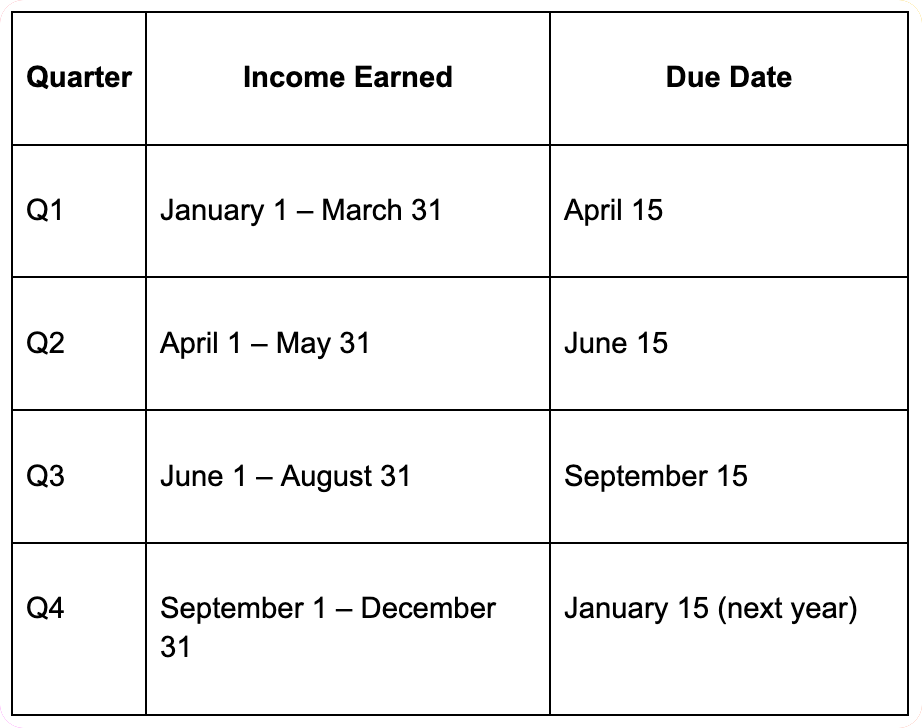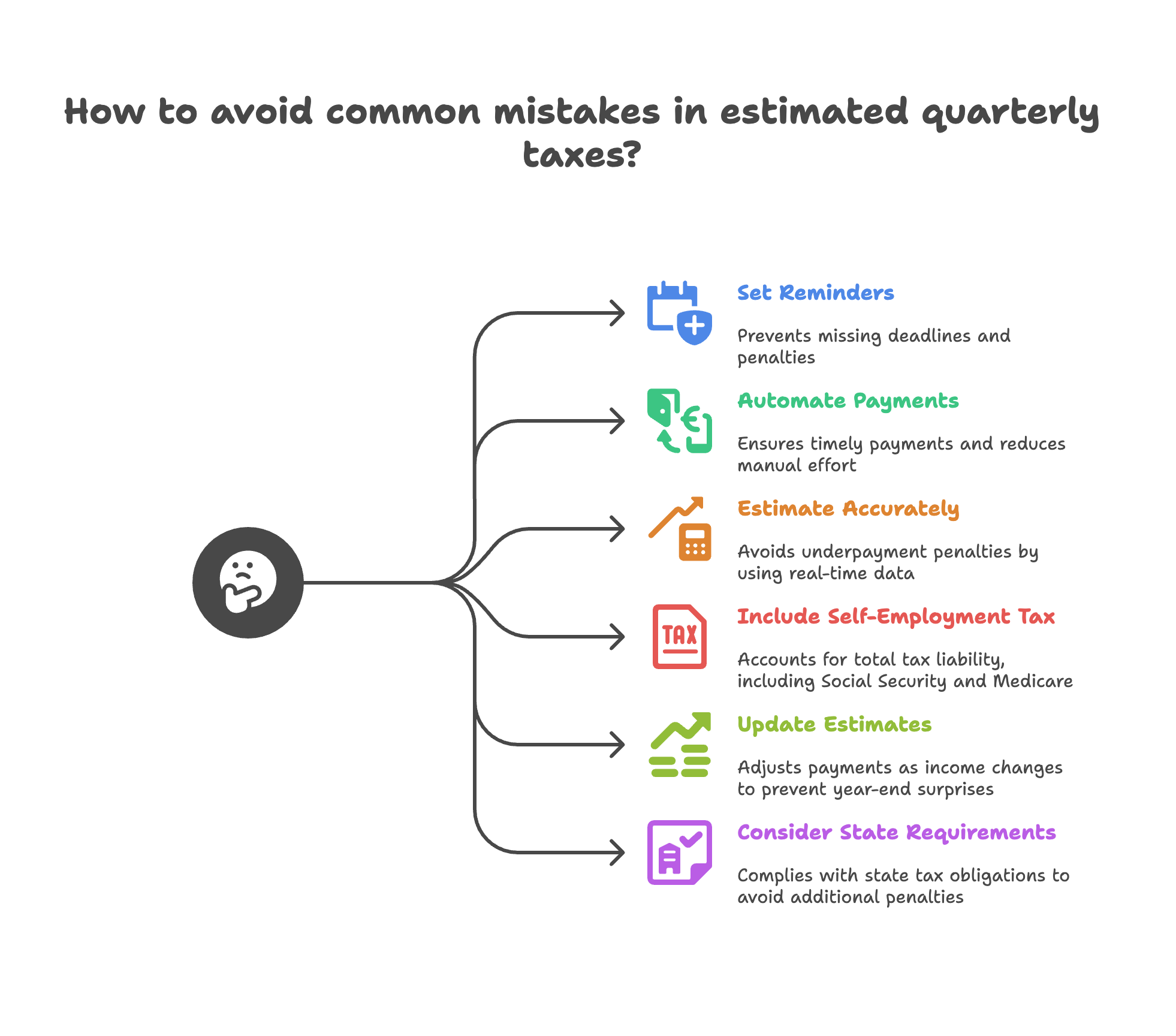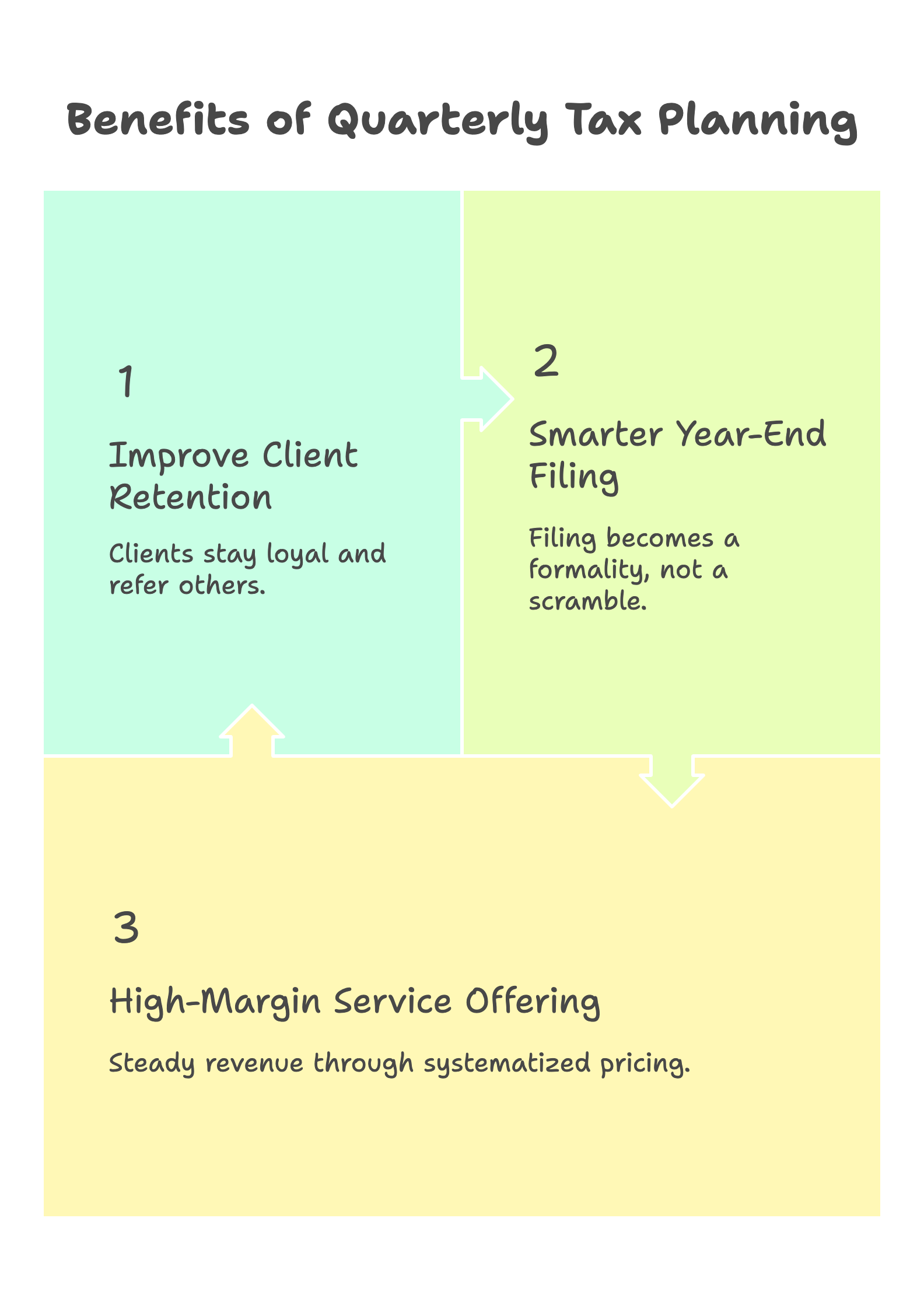Quarterly estimated tax payments often catch small business owners off guard. Unlike salaried employees whose taxes are withheld automatically through tax withholding, self-employed professionals, sole proprietors, and pass-through entity owners must take responsibility for calculating and making estimated tax payments to the IRS throughout the tax year.
Missing a due date or miscalculating what you owe can result in penalties and interest. But for most businesses, the issue is not negligence. It is confusion about when you need to pay and how much you need to pay.
What counts as income? How do you estimate your tax liability accurately? When are estimated taxes due? And what happens if your income fluctuates quarter to quarter?
In this guide, we'll answer those questions in plain language. Whether you're a small business owner trying to stay compliant or a CPA advising clients, understanding how quarterly estimated tax payments work is critical for good financial management and avoiding an estimated tax penalty.
Madras Accountancy helps CPA firms in the U.S. manage these tasks more efficiently by offering offshore support for tax projections, calculations, payment schedules, and year-end reconciliation. With our help, CPA firms save time, reduce errors, and deliver more value to their clients during tax season and throughout the year.
The IRS requires individuals and businesses to pay taxes as income is earned. If you do not have taxes withheld automatically (as is common with W-2 employees), you must pay in installments throughout the year. These are called estimated taxes.
You need to make quarterly estimated tax payments if:
Corporations must also pay estimated taxes if they expect to owe at least $500 in business tax.
Estimated taxes are not just for federal tax purposes. You may also need to make payments for self-employment tax, alternative minimum tax, and other applicable taxes. If you don't pay enough tax throughout the year, you may face penalties when you file your tax return.
Quarterly estimated taxes are due four times per tax year, but the IRS schedule is not evenly spaced. Understanding when payments are due is crucial for avoiding late penalties.
Here are the tax deadlines:

If the due date falls on a weekend or legal holiday, the deadline shifts to the next business day.
Failing to pay by these due dates can result in underpayment penalties, even if you pay in full when you file your tax return later. The IRS expects timely and regular estimated tax payments throughout the year.
There are two common ways to calculate what you owe in estimated quarterly taxes:
This method helps you avoid IRS penalties. It involves paying at least:
If you follow this rule when you pay estimated tax, the IRS generally does not penalize you for underpayment, even if your actual tax liability ends up being higher.
This method involves calculating your expected income, deductions, and credits for the year and dividing the amount of tax owed by four. It is more accurate but requires ongoing tracking of your income and expenses.
Most small business owners use a combination of both methods when making estimated payments. The safe harbor rule offers protection, while periodic re-estimates based on actual income help reduce overpayments.
If your income is irregular or seasonal, the IRS allows the annualized income installment method, which adjusts each estimated tax payment based on actual income received during the period.
When calculating your estimated quarterly taxes, it is important to understand what qualifies as taxable income. This may include:
Note: Gross receipts alone are not taxable. You must calculate net income after deducting qualified business expenses like rent, supplies, utilities, depreciation, travel, and insurance.
If you're unsure whether something is taxable, it is safer to include it when calculating your estimated taxes. A tax professional can help you determine what income should be included in your quarterly estimated tax payments.
Paying your estimated taxes is relatively straightforward once you know how much to send. The IRS offers several convenient methods for making each tax payment.
This is the most common method used by businesses and self-employed individuals who need to make estimated payments. It is free, secure, and allows you to schedule payments in advance.
To use EFTPS:
You will receive confirmation for every transaction, which helps with recordkeeping for tax preparation purposes.
Direct Pay is a quick way for individuals to pay your tax directly from their checking or savings account without needing to register.
Visit irs.gov/payments and follow the prompts to make your estimated payment.
This app allows you to make payments via Direct Pay or by linking to your EFTPS account. It is helpful if you prefer mobile access to your tax account.
If you prefer to mail a physical payment:
Third-party providers like PayUSAtax, Pay1040, and Official Payments accept card payments for a small fee. This method is not ideal for regular use due to added costs but may be helpful for last-minute tax deadlines.
Even seasoned business owners can fall into traps when it comes to estimated quarterly taxes. Here are the most common mistakes and how to avoid them:
Late payments lead to penalties, regardless of your intent. To prevent this when you pay quarterly taxes:
If you guess low on your income and pay too little, you risk underpayment penalties. Safe harbor rules can help avoid this, but it is better to base your estimates on real-time data.
Tip: Use last year's numbers as a starting point and adjust as new income comes in. You need to make estimated adjustments throughout the year if your income changes significantly.
Self-employed individuals owe both the employer and employee portion of Social Security and Medicare taxes, totaling 15.3%.
This is in addition to income tax, so your estimated payment must include:
If your income increases mid-year and you do not adjust your payments, you may fall short of what you're required to pay. Review your estimates every quarter and adjust accordingly.
Many CPA firms use rolling forecasts to fine-tune payments based on year-to-date data, helping clients avoid a large tax bill at year-end.
Many states require estimated quarterly taxes too, with their own forms, rules, and deadlines. State tax obligations can significantly impact your overall tax liability.
Your accountant should help you track multi-state obligations if your business operates in more than one jurisdiction.

For accounting firms, quarterly tax planning is not just a compliance task. It is a high-value advisory service that strengthens client trust and creates opportunities for deeper financial planning.
Here is how:
When clients avoid penalties and feel in control of their tax situation, they are more likely to stay loyal and refer others.
Quarterly planning opens the door to broader conversations about cash flow, pricing strategy, and retirement planning.
If estimated tax payments are accurate throughout the year, the year-end filing becomes a formality instead of a scramble.
Clean books and pre-planned payments mean fewer surprises and faster turnaround when clients file their tax return.
Quarterly planning can be systematized and priced as a flat fee or subscription, creating steady revenue.
You can bundle it with bookkeeping or CFO-level services, offering more comprehensive financial support.

New business owners often struggle with making estimated tax payments because they have no prior year data. In this case:
Businesses with seasonal income patterns can use the annualized income installment method:
Freelancers and contractors with unpredictable income should:
Working with a tax professional or tax preparer can significantly improve your estimated tax payment strategy:
A qualified tax professional can also help you understand whether you need to make estimated payments and how much you should pay each quarter.
Don't forget about state tax obligations when planning your estimated payments:
Modern technology can simplify the estimated tax payment process:
At Madras Accountancy, we act as an offshore extension of U.S.-based CPA firms. Our tax support team helps you manage quarterly estimates by:
This allows your team to focus on advisory conversations while we handle the documentation, tracking, and follow-through in the background.
To ensure smooth estimated tax payment management:
Quarterly estimated tax payments may seem like a burden, but they are a critical part of managing cash flow and staying compliant. For small business owners, freelancers, and partners in pass-through entities, accurate and timely payments can mean the difference between smooth operations and costly penalties.
Understanding when you need to pay, how much to pay, and the various payment methods available will help you avoid the stress and financial impact of estimated tax penalties. Whether you make quarterly estimated tax payments yourself or work with a professional, the key is to plan ahead and stay organized.
CPA firms that provide ongoing quarterly planning stand out as proactive advisors rather than reactive service providers. And with the right support, you can scale this offering efficiently and profitably.
The key to success with estimated taxes is treating them as a regular part of your business operations, not a quarterly surprise. By working with qualified professionals and using proper planning tools, you can ensure that your estimated tax payment strategy supports your business goals rather than creating unnecessary stress.
Madras Accountancy helps firms like yours streamline the back-office side of tax planning so you can deliver more value with less hassle. If you're ready to simplify tax season and make compliance a smoother ride, we're here to help.
Question: What are quarterly estimated tax payments and who needs to make them?
Answer: Quarterly estimated tax payments are advance payments toward annual tax obligations made by individuals and businesses who don't have taxes automatically withheld from their income. Self-employed individuals, business owners, investors, and others with substantial non-wage income must make these payments if they expect to owe $1,000 or more in taxes after subtracting withholding and credits. The payments cover both income tax and self-employment tax obligations, helping taxpayers avoid large year-end tax bills and underpayment penalties.
Question: When are quarterly estimated tax payments due and what are the exact deadlines?
Answer: Quarterly estimated tax payments are due on January 15, April 15, June 15, and September 15 for the previous quarter's income. If these dates fall on weekends or holidays, payments are due the next business day. The quarters don't align with calendar quarters: Q1 covers January-March (due April 15), Q2 covers April-May (due June 15), Q3 covers June-August (due September 15), and Q4 covers September-December (due January 15 of the following year). Late payments incur penalties even if you ultimately receive a tax refund.
Question: How do you calculate quarterly estimated tax payments accurately?
Answer: Calculate quarterly estimated tax payments by projecting annual income, deductions, and tax liability, then dividing by four. Use Form 1040ES for guidance and worksheets. Consider both income tax and self-employment tax (15.3% on net earnings). Alternative calculation methods include paying 100% of last year's tax liability (110% if prior year AGI exceeded $150,000) or 90% of current year expected tax. Adjust payments throughout the year based on income changes, and make larger payments early if income is front-loaded.
Question: What penalties apply for missing or underpaying quarterly estimated taxes?
Answer: Underpayment penalties apply when quarterly payments fall short of required amounts, typically calculated at current interest rates (around 7-8% annually). Penalties accrue from each payment due date until the balance is paid, even if you receive a refund when filing your return. The penalty applies separately to each quarter, so missing one payment creates penalties even if other quarters are paid correctly. Exceptions include paying 90% of current year tax, 100% of prior year tax, or qualifying for other safe harbor provisions.
Question: Can you adjust quarterly estimated tax payments during the year based on income changes?
Answer: Yes, you can adjust quarterly estimated tax payments throughout the year based on actual income and tax obligation changes. If income increases, make larger payments to avoid underpayment penalties. If income decreases, reduce subsequent payments accordingly. Use the annualized income installment method on Form 2210 if income is seasonal or irregular. This method calculates payments based on actual quarterly income rather than annual projections, providing more accurate payment amounts for variable income situations.
Question: What payment methods are available for making quarterly estimated tax payments?
Answer: Quarterly estimated tax payments can be made online through IRS Direct Pay or Electronic Federal Tax Payment System (EFTPS), by phone using automated systems, by mail with Form 1040ES payment vouchers, or through tax preparation software. Online payments are processed immediately and provide confirmation receipts. Bank transfers are free, while credit card payments incur processing fees of 1.87-1.99%. Schedule automatic payments through EFTPS to avoid missing deadlines, and always keep payment confirmations for your records.
Question: How do quarterly estimated tax payments work for business owners with variable income?
Answer: Business owners with variable income should base quarterly payments on realistic income projections, adjusting throughout the year as actual results become known. Consider seasonal patterns, expected large contracts, and business cycle variations when calculating payments. Make conservative estimates early, then true up with larger payments if income exceeds projections. Use the annualized income method if income varies significantly by quarter. Maintain cash reserves for tax payments and consider working with tax professionals to optimize payment timing and amounts.
Question: What happens if you overpay quarterly estimated taxes during the year?
Answer: Overpaying quarterly estimated taxes results in a refund when filing your annual tax return, or you can apply the excess to next year's estimated tax payments. The IRS doesn't pay interest on overpayments from estimated tax payments. While overpaying avoids penalties, it ties up cash that could be used for business operations or investments. Consider reducing subsequent quarterly payments if you've significantly overpaid early in the year, but ensure you still meet minimum payment requirements to avoid underpayment penalties.
.png)
December 9, 2025
A straight-talking overview of five small business tax prep options in 2025, including Madras Accountancy, TurboTax, H&R Block, TaxSlayer, and Bench’s books-plus-tax model.

December 9, 2025
An on-the-ground guide to the UK’s fractional CFO ecosystem – London and beyond – including The CFO Centre, fin-house, FD Capital, BKL, BSmart, and how Madras Accountancy fits into cross-border and hybrid models.